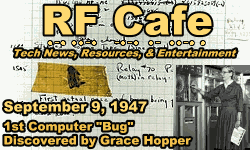|
 September 9 September 9
 1737: Italian physician
Luigi Galvani,
after whom the word "galvanic" is named, was born. 1776: The 2nd Continental Congress
replaced "United Colonies" with the "United States." 1839:
John Herschel
took the first glass plate photograph. 1890:
Harland Sanders, the founder of Kentucky Fried Chicken, was born
(he was not a colonel). 1909:
Arthur (Art)
Collins, of Collins Radio Company, was born. 1914:
John Poynting,
who introduced a theorem that assigns a value to the rate of flow of electromagnetic
energy known as the
Poynting vector, was born. 1926: The
National Broadcasting
Company (NBC) was created by the
Radio Corporation of America (RCA). 1941:
Dennis Richie, developer of the "C" programming language, was
born. 1942: Japan dropped
incendiaries over Oregon in an unsuccessful attempt to set fire
to the forests in Oregon and Washington. 1947: The first "bug" in a computer
program was discovered by Grace Hopper - a moth was removed with tweezers from a relay and
taped into the log. 1975: NASA launched the
Viking 2
spacecraft to Mars. 1982: The world's first private rocket, "Conestoga
I", was launched. 2003:
Edward Teller,
"father of the H-bomb," died. 1737: Italian physician
Luigi Galvani,
after whom the word "galvanic" is named, was born. 1776: The 2nd Continental Congress
replaced "United Colonies" with the "United States." 1839:
John Herschel
took the first glass plate photograph. 1890:
Harland Sanders, the founder of Kentucky Fried Chicken, was born
(he was not a colonel). 1909:
Arthur (Art)
Collins, of Collins Radio Company, was born. 1914:
John Poynting,
who introduced a theorem that assigns a value to the rate of flow of electromagnetic
energy known as the
Poynting vector, was born. 1926: The
National Broadcasting
Company (NBC) was created by the
Radio Corporation of America (RCA). 1941:
Dennis Richie, developer of the "C" programming language, was
born. 1942: Japan dropped
incendiaries over Oregon in an unsuccessful attempt to set fire
to the forests in Oregon and Washington. 1947: The first "bug" in a computer
program was discovered by Grace Hopper - a moth was removed with tweezers from a relay and
taped into the log. 1975: NASA launched the
Viking 2
spacecraft to Mars. 1982: The world's first private rocket, "Conestoga
I", was launched. 2003:
Edward Teller,
"father of the H-bomb," died.
| Jan
| Feb | Mar |
Apr | May |
Jun | Jul |
Aug | Sep |
Oct | Nov |
Dec |
Note: These
historical tidbits have been collected from various sources, mostly on the Internet.
As detailed in
this article, there
is a lot of wrong information that is repeated hundreds of times because most websites
do not validate with authoritative sources. On RF Cafe, events with
hyperlinks have been verified. Many years ago,
I began commemorating the birthdays of notable people and events with
special RF Cafe logos.
Where available, I like to use images from postage stamps from the country where
the person or event occurred. Images used in the logos are often from open source
websites like Wikipedia, and are specifically credited with a hyperlink back to
the source where possible.
Fair Use laws permit
small samples of copyrighted content.
|
 September 9
September 9